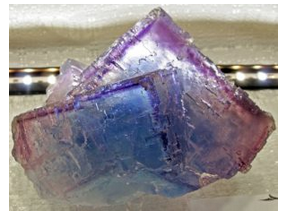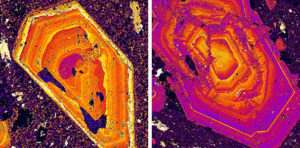4.4.5: Crystal Zoning
- Page ID
- 19159

Crystallizing magmas may produce uneven mineral distribution within a rock. On a smaller scale, individual minerals develop compositional zoning if different parts of a mineral have different compositions. Zoning is present in many minerals but often on such a small scale that we have difficulty detecting it. Sometimes, however, zones of different compositions are large and have different colors – as can be seen in these fluorite crystals from China (Figure 4.37). Look, also, at the zoned tourmaline crystal in Figure 4.13, earlier in this chapter. Often – even if not visible with the naked eye – zoning can be seen with a petrographic microscope because zones of different composition have different optical properties. In still other cases detailed chemical analyses are needed to detect zoning’s presence. Note that, in contrast with the fluorite in Figure 4.37, there is no visible zoning in the fluorite seen in Figure 4.3 (near the start of this chapter).

Most zoning is an artifact of crystal growth. It may result from changes in pressure or temperature during crystallization. It may also result from changes in magma or fluid composition as crystals grow. The principles of thermodynamics dictate that zoned minerals are unstable and should homogenize over time. But they are common in nature because diffusion of elements is often not fast enough for growing minerals to remain homogeneous. Most zoning is concentric, forming as growth rings about an original crystal seed. Occasionally, it is more complex and results in compositional zones that are difficult to explain and interpret. The colorful images seen in Figure 4.38 show zoned plagioclase in an igneous rock. These images were obtained with a scanning electron microscope (SEM) and the colors show domains of different compositions that developed as the crystals grew.


